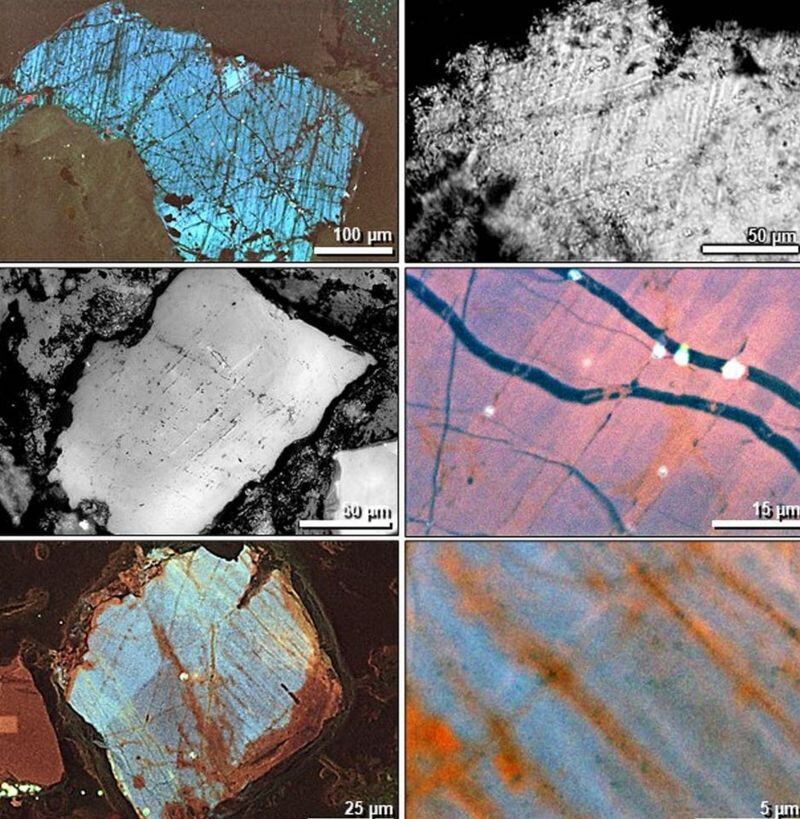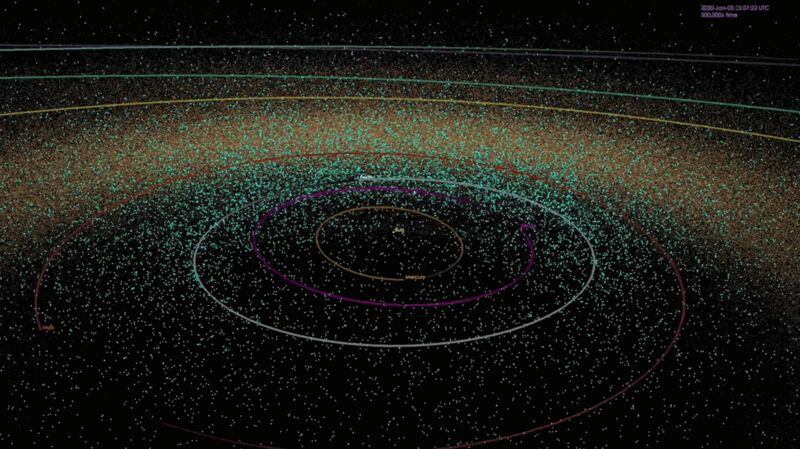One day some 3,600 years ago, the inhabitants of an ancient Middle Eastern city now called Tall el-Hammam went about their daily activities unaware that an invisible icy space rock was approaching them at a speed of approximately 61,000 kilometers per hour.
Flashing through the atmosphere, the rock exploded in a huge fireball about 4 kilometers above the ground.
SIGHT: The Architectural Wonders of Millennial Desert Manhattan
The explosion was a 1,000 times more powerful than Hiroshima’s atomic bomb.
The shocked city dwellers who looked at her were instantly blinded. The air temperature rose rapidly above 3,600 degrees Fahrenheit (2,000 degrees Celsius).
- What are the prop weapons used in film shoots like and why are they dangerous?
- How was the accident in which actor Brandon Lee died during a shoot almost 3 decades ago
- The coincidence without which Marco Polo would not have been famous
The clothing and wood immediately burst into flames. Swords, spears, adobe, and pottery began to melt.
Almost immediately, the entire city caught fire.
A few seconds later, a massive seismic wave shook the city. Moving at about 1,200 km / h, it was more powerful than the worst tornado ever recorded.
Deadly winds swept through the city, demolishing all the buildings. They tore off the top 12 meters of the four-story palace and threw the scrambled rubble down the next valley.
None of the 8,000 people or animals in the city survived: Their bodies were smashed and their bones exploded into splinters.
About a minute later, 22 km west of Tall el-Hammam, the blast winds reached the biblical city of Jericho. Its walls collapsed and the city burned to the ground.
It all sounds like the climax of a Hollywood disaster movie. How do we know that all of this actually happened in that place near the Dead Sea in Jordan millennia ago?
Getting answers required nearly 15 years of painstaking excavation by hundreds of people.
It also involved detailed analyzes of material excavated by more than two dozen scientists in 10 US states, as well as Canada and the Czech Republic.
When our group finally published the evidence recently in Scientific Reports, the 21 co-authors included archaeologists, geologists, geochemists, geomorphologists, mineralogists, paleobotanists, sedimentologists, cosmic impact experts, and physicians.
This is how we build this image of devastation in the past.
Firestorm all over town
Years ago, when archaeologists looked at excavations of the ruined city, they could see a dark, messy blanket roughly 1.5 meters thick of coal, ash and adobe and melted pottery.
It was obvious that an intense firestorm had destroyed this city long ago. This dark band was renamed the layer of destruction.

No one was sure what exactly happened, but that layer was not caused by a volcano, an earthquake, or a war. None of that is capable of melting metal, adobe and ceramic.
To find out what might have been, our group used the “Online Impact Calculator” to model scenarios that fit the evidence.
Built by impact experts, this tool allows researchers to estimate the many details of a cosmic impact event, based on other known impact events and nuclear detonations.
Apparently the culprit at Tall el-Hammam had been a small asteroid similar to the one that toppled 80 million trees in Tunguska, Russia in 1908. It would have been a much smaller version of the kilometer-wide giant rock that pushed the dinosaurs away. to extinction 65 million years ago.
We had a possible cause. Now we needed proof of what happened that day in Tall el-Hammam.
Finding “diamonds” on earth
Our investigation revealed a remarkably wide variety of evidence.
At the site there are finely fractured grains of sand called impacted quartz that only form at 725,000 pounds per square inch of pressure (5 gigapascals); imagine six 68-ton Abrams military tanks stacked on your thumb.

The destruction layer also contains tiny diamonoids which, as the name suggests, are as hard as diamonds. Each one is smaller than a flu virus.
It seems that wood and plants in the area were instantly turned into this diamond-like material by the high pressures and temperatures of the fireball.
Laboratory furnace experiments showed that the bubbled pottery and mud bricks at Tall el-Hammam liquefied at temperatures above 1,500 ° C. That’s hot enough to melt a car in a matter of minutes.
The destruction layer also contains balls of molten material smaller than airborne dust particles. Called spherules, they are made of vaporized iron and sand that melted at approximately 1,590 ° C.
Additionally, ceramic and molten glass surfaces are speckled with tiny, melted metallic grains, including iridium with a melting point of 2,466 ° C, platinum that melts at 1,768 ° C, and zirconium silicate at 1,540 ° C.

Taken together, all this evidence shows that temperatures in the city rose more than those of volcanoes, war, and normal city fires. The only natural process left is a cosmic impact.
The same evidence is found at known impact sites, such as Tunguska and the Chicxulub crater, created by the asteroid that caused the dinosaurs to go extinct.
A remaining puzzle is why the city and more than 100 settlements in other areas were abandoned for several centuries after this devastation.
It may be that the high levels of salt deposited during the impact event made cultivation impossible.
We’re not sure yet, but we believe the explosion may have vaporized or splashed toxic levels of saltwater from the Dead Sea throughout the valley.
Without crops, no one would have been able to live there for about 600 years, until minimal rainfall in this desert climate washed the salt off the fields.
Did any witnesses survive the explosion?
An oral description of the city’s destruction may have been passed down for generations until it was recorded as the story of biblical Sodom.
The Bible describes the devastation of an urban center near the Dead Sea: stones and fire fell from the sky, more than one city was destroyed, thick smoke rose from the fires, and the city’s inhabitants died.
Could this be an ancient eyewitness account?
If so, the destruction of Tall el-Hammam may be the second oldest destruction of a human settlement by a cosmic impact event, after the village of Abu Hureyra in Syria some 12,800 years ago.
Importantly, it may be the first written record of such a catastrophic event.
Startling
What is scary is that it will almost certainly not be the last time a human city faces this fate.

Tunguska-sized air explosions, such as the one that occurred in Tall el-Hammam, can devastate entire cities and regions, and pose a grave danger today.
Since September 2021, there are more than 26,000 known asteroids and a hundred near-Earth short-period comets. One will inevitably crash into the planet. Millions more remain undetected.
Unless ground-based or orbiting telescopes detect these rogue objects, the world may not have any warning, as do the people of Tall el-Hammam.
* This article was co-written by the research collaborators, the archaeologist Phil Silvia, geophysicist Allen West, the geologist Ted Bunch and the space physicist Malcolm LeCompte.
Read the original article here.
_________________________________
- They ate at the Salt Bae restaurant and the service alone cost thousands of dollars
- Nikolas Cruz: Perpetrator of Parkland School Massacre Pleads Guilty to All Charges
- Before she died, teacher Mary Kay Letourneau felt remorse for her relationship with her 12-year-old student
- Mexico: mother would have embalmed her daughter and put it as a mannequin in her store
- They find the belongings of the missing boyfriend of Gabby Petito, the young woman who was murdered in the United States.
- They release the “murderer with red hair”, who at age 13 abused and killed a 4-year-old boy
.

:quality(75)/cloudfront-us-east-1.images.arcpublishing.com/elcomercio/FM66KWYXDZHOPGFSJZN3EULOCU.jpg)

:quality(75)/cloudfront-us-east-1.images.arcpublishing.com/elcomercio/JM25IBFQDFHFFK4YZMOODBT4WU.jpg)
:quality(75)/cloudfront-us-east-1.images.arcpublishing.com/elcomercio/JGMWAQN3YVBCFOLPBHZ7HFVKXI.jpg)
:quality(75)/cloudfront-us-east-1.images.arcpublishing.com/elcomercio/PYBBKOVGC5HH3BFSADLGZPRBCA.jpg)

